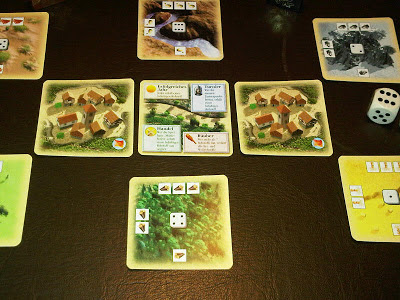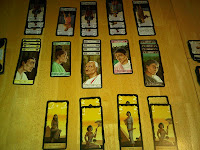Next up was a serious step back in complexity, Tally Ho! by Rudi Hoffmann. This was a new acquisition since we started this series.
In Tally Ho!, one player plays the humans, composed of the Hunters and the Lumberjacks, while the other player plays the Foxes and the Bears. The object is to hunt the other player's tiles. Stuck in the middle are the innocent ducks, and pheasants, which are hunted by all.
The board is a big grid with 49 spaces. The tiles are placed face down at the start of the game and the players take turns turning them face up, being careful not to change their orientation. Alternatively, rather than turn a tile face up, a player can move one of his own already face up tiles or move one of the neutral duck and pheasant tiles. Bears and Lumberjacks only move one space in a turn while all other tiles can move any amount through empty spaces.
Each of a player's tiles has a specific "prey" it can attack by moving onto its space. The Fox can eat the ducks and pheasants for two and three points, respectively. The Lumberjack can chop down one tree for two points. The Bears can eat a Hunter or a Lumberjack for five points each. The Hunter can shoot any of the animals, the Fox worth five points and the Bear worth the most at ten. The Hunter, however, may only attack in the direction his gun is pointing and can't turn during the game (which is why you can't change the orientation of the tiles when turning them over). You can have a whole bunch of Hunters face up, but if they're not pointing in the right direction you have problems.
Once the last tile is turned face up, each player gets five more turns. During these turns, players can move their own tiles off the board, scoring them. Players note the scores, switch sides and play another round. Highest score after two rounds wins the game.
There is a good deal of luck in Tally Ho! due to the random distribution of tiles. But I like the tactical movement and the way you can use the ducks and pheasants to block the actions of the other player. The game feels a bit like chess in the way it plays, but is of course much easier and quicker.
During the first round I was the Hunter while Carol was the animals. Trees block movement, making it more difficult to move around the board, especially for the Hunter. Turning up the Lumberjacks early helps the Hunter clear the trees and gain movement. Unfortunately, I didn't find my Lumberjacks until late in the game, giving Carol some advantage.
At the end of the first round, in addition to pheasants and ducks, I had killed one Bear and only cut down one tree for a score of 39. Carol had killed four of my Hunters and one Lumberjack. She easily won the round 62 to 39.
Taking over the animals during the second round, I wailed on the ducks and pheasants with my Foxes but had trouble cornering Carol's Hunters. In the meantime, she had found her Lumberjacks and cut down a ton of trees, making movement easier. At the end of the round I had killed two Hunters and no Lumberjacks, while she had killed one of my Bears and cut down ten trees.
Final scores:
Carol 62 + 73 = 135
Bob 39 + 52 = 91
Coming up: We build a medieval fortress and a cathedral in the unnecessarily long-named The Pillars of the Earth: Builders Duel.


























